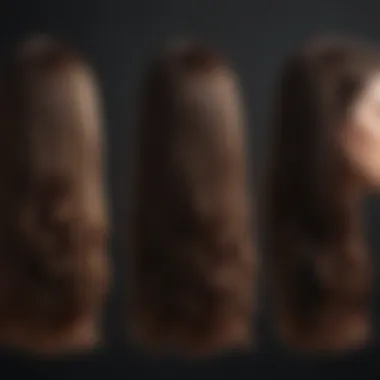Understanding Normal Hair Shedding: A Comprehensive Guide


Intro
Understanding normal hair shedding can help individuals distinguish between what is typically expected and what may indicate a concern for hair health. Shedding is a natural process that can be perplexing, especially when it occurs in noticeable amounts. Many people worry about their hair loss, not realizing that some shedding is completely normal.
This article aims to clarify the characteristics of normal shedding and detail the factors influencing it. By outlining hair growth cycles, environmental factors, and health conditions, readers will gain the knowledge necessary to assess their hair health. It is crucial to recognize that while shedding can evoke concern, it does not always signify a serious issue. Monitoring one’s hair shedding is essential for understanding personal health and making informed decisions regarding hair care.
Hair Growth Cycles
The hair on the human body goes through distinct phases known as the hair growth cycle. This cycle consists of three main stages: anagen, catagen, and telogen.
- Anagen Phase: This is the growth phase where hair follicles actively produce hair. This stage can last several years, depending on genetics and overall health.
- Catagen Phase: Following the growth phase, the hair enters a transitional stage. During this brief period, hair stops growing and detaches from its blood supply. This phase typically lasts a few weeks.
- Telogen Phase: This final phase is when hair rests. Around 10-15% of hair strands are in this stage at any given time. After this phase, the hair will eventually shed, making way for new growth.
A typical individual sheds about 50 to 100 hairs daily. This shedding is generally a natural part of the cycle, indicating that new hair is developing beneath.
Environmental Impact
Various environmental factors can influence hair shedding. Changes in weather, exposure to sun, and humidity can impact hair health.
- Seasonal Changes: During periods such as fall and winter, individuals may notice increased shedding. This can be attributed to changes in temperature and humidity.
- Chemical Exposure: Exposure to harsh chemicals in hair products, as well as pollutants in the environment, can lead to damage and increased shedding.
- Diet: Nutrition also plays a crucial role in hair health. A lack of essential vitamins and minerals can lead to weakened hair, making it more susceptible to shedding.
Health Conditions to Monitor
Understanding when shedding may be a concern involves recognizing any accompanying symptoms. Hair loss that is localized or excessive may indicate an underlying health issue. Some conditions include:
- Alopecia Areata: An autoimmune condition that causes patchy hair loss.
- Thyroid Disorders: An underactive or overactive thyroid can lead to changes in hair shedding.
- Hormonal Changes: Pregnancies, menopause, and hormonal imbalances can trigger increased shedding.
It is important to consider consulting a healthcare professional if there are signs of excessive shedding, as it may require further investigation.
Epilogue
In summary, normal hair shedding is a process governed by the hair growth cycle, influenced by environmental factors, and potentially affected by health conditions. By understanding these elements, individuals can better evaluate their hair health. Monitoring hair shedding and being aware of changes can help one decide when to seek professional advice for potential concerns.
This knowledge empowers individuals to approach the topic of hair care with clarity and confidence.
What Is Normal Hair Shedding?
Understanding what constitutes normal hair shedding is crucial for those who wish to maintain healthy hair and scalp conditions. Shedding is a natural part of the hair growth cycle, but recognizing the difference between normal shedding and excessive loss is essential. A thorough grasp of this topic assists individuals in distinguishing when their hair loss may not be a cause for concern, and when it might signal underlying issues. Furthermore, awareness of the factors influencing shedding can lead to better hair care strategies and overall health management.
Defining Hair Shedding
Hair shedding refers to the natural process where hair strands fall out from the scalp. It is important to recognize that shedding is not synonymous with hair loss; despite shedding being a routine occurrence, it can still evoke anxiety, particularly when strands appear in greater quantities than expected. Typically, individuals may lose between 50 to 100 hairs a day, largely as a result of the hair growth cycle. Understanding this cycle helps clarify that shedding is an essential biological function involving the renewal of hair follicles.
The Mechanics of Shedding
The mechanics of hair shedding are intertwined with the hair growth cycle. This process includes three key phases: anagen, catagen, and telogen, each serving its own purpose. During the anagen phase, hair actively grows, lasting several years. The catagen phase is a transitional period, lasting only a few weeks, in which the hair follicle shrinks. Finally, the telogen phase is when the hair is dormant, eventually leading to its shedding. Any disturbance or fluctuations within these phases can influence shedding rates, shedding light on the complexity behind what many consider a simple process.
Normal hair shedding should not pose a significant concern to one’s health, but understanding the mechanism helps in monitoring changes.
By focusing on these basic components of hair shedding, individuals can start to comprehend the nuances of their hair health. This foundation sets the stage for future discussions on hair growth cycles and related factors, enlightening those who need clarity regarding normal hair shedding.
The Hair Growth Cycle
Understanding the hair growth cycle is essential for comprehending normal hair shedding. The cycle consists of distinct phases that hair follicles undergo, each playing a significant role in hair health and the shedding process. Recognizing these phases helps in identifying what constitutes typical shedding versus potential hair loss issues.
Anagen Phase


The anagen phase is the first and most crucial stage of the hair growth cycle. During this phase, which can last several years—typically between two to seven years—the hair actively grows. The length and health of hair depend largely on how long it remains in this phase. A longer anagen phase results in longer hair, while a shorter one may lead to shorter strands.
Hair follicles are highly active in this stage, producing new cells that push older ones up, forming the visible hair shaft.
Factors influencing this phase include genetics, overall health, and diet. Those with a balanced diet rich in vitamins and minerals often see better growth outcomes. This phase also offers psychological benefits, as abundant, healthy hair can enhance self-esteem and body image. Monitoring changes in growth during the anagen phase is key to understanding individual hair shedding patterns.
Catagen Phase
The catagen phase is a transitional stage that lasts about two to three weeks. Here, hair growth slows, and the hair follicle begins to shrink. During this time, the lower part of the hair follicle undergoes a process of apoptosis, which leads to the hair shaft detaching from the follicle. This is a natural and necessary step in the hair growth cycle.
While it may seem alarming, this phase is not indicative of hair loss but rather a normal part of the cycle. It's a brief period of adjustment before the hair enters the next phase. It's important to note that not all hair follicles will simultaneously enter the catagen phase, leading to a balance of hair growth and shedding.
Additionally, this phase can be affected by external factors. Hormonal changes, health conditions, and stress levels may cause premature entry into the catagen phase, which could alter shedding rates.
Telogen Phase
The telogen phase is the final stage of the hair growth cycle and lasts for about three months. By now, the hair is resting, and this phase is when shedding occurs. At the end of the telogen phase, the hair will fall out, making way for new hair growth to resume the cycle. This process is entirely normal and reflects healthy hair regeneration.
During this phase, it’s common to shed around 50 to 100 hairs daily. Individual variations exist based on factors such as age, health, and season. For instance, some people may experience increased shedding during seasonal transitions.
Understanding the telogen phase is critical for individuals who are concerned about hair loss. When shedding goes beyond the normal threshold, it could signal underlying health issues. Therefore, monitoring shedding during this phase becomes essential for identifying problems early on.
Recognizing and understanding the phases of the hair growth cycle provides insights into normal shedding patterns. Individuals can differentiate between everyday shedding and alarming hair loss, leading to informed decisions about hair care and health.
Typical Hair Shedding Rates
Understanding typical hair shedding rates is crucial for many individuals, especially those concerned about their hair health. Many people often worry about hair loss when they notice hair strands on their pillow or in the shower. However, recognizing what constitutes normal shedding can alleviate unnecessary anxiety and provide a clearer picture of hair health.
Hair shedding is a natural process. The average person sheds between 50 to 100 hairs per day, depending on various factors. Knowing this norm helps establish a baseline for what is typical and when further investigation may be necessary.
Common indicators of normal shedding include:
- Hair found in brushes or on clothing after wear.
- Shedding during washing or styling, especially in the shower.
- Minimal clumping or excessive amounts in one location.
Being mindful of these factors can prevent concern over normal day-to-day shedding while allowing individuals to monitor any notable increases that may signal other issues.
Daily Shedding Norms
Normal daily shedding looks different for everyone. Most people lose a few hairs each time they brush or wash their hair. Factors such as hair type and overall health influence these rates. Studies have shown that those with long hair might notice more strands due to the visibility of longer hair compared with shorter styles.
To assess your own shedding rate:
- Observe hair loss daily for a week.
- Record hairs collected in a brush or during shampooing.
This can help provide a clearer indication if your shedding is within the normal range.
Factors Influencing Shedding Rates
Multiple factors impact daily hair shedding rates. Some of the most significant include:
- Genetics: Individuals may have a hereditary tendency for higher or lower shedding rates.
- Health Conditions: Certain medical conditions, including thyroid disorders or autoimmune diseases, can increase shedding.
- Medications: Some drugs have side effects that lead to hair loss.
- Hormonal Fluctuations: Hormonal changes related to puberty, menstruation, or menopause can affect shedding.
- Seasonal Changes: Many individuals experience increased shedding in spring and fall, possibly due to environmental transitions.
By being aware of these influencing factors, you gain insight into your hair's behavior, thus further understanding your shedding patterns.
Visual Indicators of Normal Shedding


Understanding the visual indicators of normal shedding is essential for anyone concerned about their hair health. Recognizing normal patterns can reduce anxiety around hair loss and assist in differentiating between what is typical and what may require further investigation. These indicators include the appearance of shed hairs, the density of hair on the scalp, and the overall health of the hair strands. By knowing what to look for, individuals can make informed decisions regarding their hair care and seek help when necessary.
What Normal Shedding Looks Like
Normal shedding typically manifests in specific ways. On average, individuals may lose between 50 to 100 hairs a day. This shedding can be observed during various daily activities, such as brushing or washing hair. The hairs that fall out are usually in a state of consistent length and are often accompanied by the hair’s root bulb. The bulb is a small, whitish structure at the end of a strand of hair, indicating that the strand is at the end of its growth cycle. It's important to note that most shed hairs are not a cause for concern unless there is a noticeable increase in the quantity of hair lost.
Visual cues to identify normal shedding may include:
- Single strands: Normal shedding often involves individual hair strands rather than clumps.
- Root presence: Check for bulbs at the end of shed hairs.
- Consistent texture: The shed hair should have a consistent thickness and elasticity, indicating healthy growth prior to shedding.
Being aware of these signs can help individuals discern if they are experiencing normal shedding or something more serious that requires professional attention.
Shedding vs. Hair Loss
It is vital to draw a distinction between shedding and hair loss. While shedding is a natural, continuous process, hair loss refers to a more significant and often alarming decrease in hair density. Hair loss can be categorized into various types, including pattern baldness, alopecia, and other conditions resulting from medical issues or stress.
Key differences between shedding and hair loss include:
- Volume: Shedding usually involves a small quantity of hair; hair loss can result in noticeable bald patches or thinning.
- Growth cycle phases: Typically, individuals may still see hair actively growing in cases of normal shedding, while hair loss may disrupt this cycle.
- Duration and change: Sudden changes in shedding rates may indicate hair loss, while normal shedding remains consistent over time.
"Understanding these differences can empower individuals to address their concerns more effectively, either by improving hair care routines or by consulting a healthcare professional for specialized advice."
In summary, grasping the visual indicators of normal shedding allows for a clearer outlook on hair health. Individuals can take proactive steps to maintain their hair's vitality and seek help if the pattern changes in ways that signal potential hair loss.
Temporary Factors Impacting Shedding
Understanding the temporary factors that affect hair shedding is crucial in distinguishing normal hair behavior from concerning loss. Various elements can trigger fluctuations in shedding rates. These factors can be environmental, psychological, or dietary in nature. Recognizing these influences helps individuals better manage their hair health. Furthermore, knowing when shedding is temporary can reduce unnecessary worry and promote a more informed approach to hair care.
Seasonal Shedding Patterns
Hair is subject to seasonal variations, much like many biological processes. Some may notice increased hair shedding during certain times of the year—especially spring and autumn. This pattern is typically linked to changes in temperature, humidity, and daylight, which affect both the hair growth cycle and shedding process.
Research suggests that during spring, as temperatures rise, more hairs transition from the telogen phase into shedding. In the autumn months, environmental changes can prompt similar reactions. Consequently, this seasonal shedding is generally temporary and self-resolving, without resulting in long-term thinning.
Stress and Hair Shedding
Stress is another significant factor that can influence hair shedding. Emotional or physical stress can trigger a condition known as telogen effluvium. In this situation, a percentage of hair follicles prematurely enter the telogen phase, leading to increased shedding weeks or months after the stressful incident. Stressors can range from major life changes, such as job loss or illness, to more mundane everyday challenges. It is essential for individuals to identify and manage stressors effectively to mitigate their impact on hair health.
Dietary Influences
Diet plays a pivotal role in overall hair health, and inadequate nutrition can contribute to increased shedding. Hair follicles require specific nutrients for optimal growth and maintenance. Deficiencies in vitamins, especially B vitamins, and minerals, like iron and zinc, can weaken hair and lead to increased shedding. Incorporating a balanced diet rich in these essential nutrients can help maintain normal hair function. Foods such as leafy greens, nuts, seeds, and lean proteins should be included in daily meals for better hair health.
Understanding these temporary factors is vital for recognizing normal variations in hair shedding. Monitoring your environment, stress levels, and dietary habits can empower individuals with the tools needed to support healthy hair.
Long-Term Changes in Hair Shedding
Long-term changes in hair shedding are critical for understanding how various factors can influence hair health over time. Many individuals may not realize that hair shedding patterns can evolve due to factors like aging or hormonal shifts. Recognizing these changes can inform one’s approach to hair care and health management. This section focuses on two primary influences: age and hormonal changes.
Age-Related Changes
As people age, it is common to experience shifts in hair growth and shedding. The hair growth cycle naturally slows down, and individuals may notice that their hair has become thinner or less vibrant. Specifically, the length of the anagen phase—the active growth segment of hair—can shorten, resulting in fewer hairs being produced.
Some key points about age-related changes include:
- Thinning Hair: Many individuals in their late 40s and beyond may experience a gradual thinning of hair.
- Decrease in Density: Hair strands may spread out and appear less dense, even if shedding rates remain within the normal range.
- Changes in Texture: Some may observe a shift in hair texture, with hair becoming finer and more fragile and more prone to breakage.
- Impact on Hair Growth Rate: The rate at which hair grows may decline, leading to longer intervals between noticeable hair renewal.


Acknowledging these age-related changes allows individuals to adapt their hair care routines effectively. For example, they may opt for thicker hair products or regular scalp massages to stimulate blood flow.
Hormonal Changes and Shedding
Hormonal fluctuations significantly impact hair shedding patterns. Conditions such as pregnancy, menopause, or the use of hormonal therapies can result in increased shedding. These changes can be distressing for those experiencing them, and understanding the underlying mechanics can provide reassurance.
Factors to consider include:
- Pregnancy: Hormonal surges during pregnancy often lead to increased anagen activity, resulting in less shedding. However, after childbirth, a dramatic hormonal shift can trigger a temporary increase in shedding, commonly referred to as postpartum hair loss.
- Menopause: During menopause, declining estrogen levels can result in hair thinning and increased shedding. The hormonal balance shifts away from supportive and towards more problematic states, which can affect hair density.
- Hormonal Disorders: Conditions such as polycystic ovary syndrome (PCOS) can result in elevated androgen levels, leading to more aggressive thinning and shedding.
Hormonal imbalances are often temporary and can be addressed through lifestyle changes or medical interventions.
Managing hormone-related hair changes may require professional assessment, particularly when there is a noticeable shift. Consulting with a healthcare provider can help tailor solutions to alleviate excessive shedding.
Recognizing long-term changes in hair shedding is integral to individualized care. As one's body changes due to age and hormones, staying informed can make a significant difference in maintaining healthy hair.
When to Seek Professional Help
In the realm of hair health, recognizing when to consult a professional is crucial. While normal hair shedding is a common occurrence, certain signs may indicate potential underlying issues. Seeking timely advice can prevent further complications and help maintain overall hair health. This section elucidates the specific elements that warrant professional consultation and the benefits of addressing hair shedding concerns promptly.
Signs of Excessive Shedding
Identifying excessive hair shedding involves understanding the typical thresholds of loss. Here are some key indicators:
- Increased Hair on Pillow or in Shower: Noticing a significant uptick in hair strands on your pillow each morning or clogged drains after showers can be a palpable sign of concern.
- Visible Thinning on Scalp: A more pronounced appearance of the scalp can signal alarming levels of hair loss, which should not be ignored.
- Unusual Hair Texture Changes: If your hair feels finer or more fragile than usual, this may suggest changes that need professional insight.
- Family History of Hair Loss: Understanding personal and family genetics helps inform risks. If close relatives have experienced hair loss, it is wise to monitor your hair health more closely.
These signs may not always point to a severe problem, but they are essential markers indicating a possible need for professional evaluation.
Diagnostic Approaches
When excessive shedding is suspected, various diagnostic approaches can clarify the situation. Health professionals may employ several methods to accurately assess the condition. Common diagnostic practices include:
- Scalp Examination: A thorough inspection of the scalp by a dermatologist for signs of inflammation, redness, or scalp conditions.
- Hair Pull Test: This simple assessment involves gently pulling on a group of hair strands to determine how many come out, which can help gauge the severity of shedding.
- Blood Tests: Evaluating blood work can uncover nutritional deficiencies, hormonal imbalances, or underlying health issues contributing to hair loss.
- Biopsy: In rare cases, a scalp biopsy may be recommended to evaluate hair follicles and rule out disorders such as alopecia or other dermatological conditions.
"Early intervention is key in managing hair health. Understanding when to seek help can make all the difference in preserving your hair’s vitality."
Timely diagnostics lead to appropriate treatment strategies, aiding in the prevention of further hair loss. If you observe any of the mentioned signs, it is advisable to seek the opinion of a qualified professional.
Preventive Strategies for Healthy Hair
Preventive strategies for maintaining healthy hair are essential for minimizing excessive shedding. Understanding these strategies enables individuals to take proactive steps to preserve their hair health and nurture strong growth. A focus on nutrition and hair care techniques forms the backbone of effective prevention. Through careful consideration of these aspects, one can not only manage normal shedding but also enhance overall hair vitality.
Nutritional Considerations
Nutrition plays an undeniable role in the condition of hair. A well-balanced diet can significantly impact hair growth and shedding rates. Key nutrients such as proteins, vitamins, and minerals promote healthy follicles and support the hair growth cycle.
- Proteins: Hair is primarily composed of keratin, a type of protein. Incorporating protein-rich foods like lean meats, fish, eggs, and legumes can lay the groundwork for healthier hair.
- Vitamins: Biotin, Vitamin A, C, and E are crucial for maintaining robust hair. These vitamins aid in building keratin and protecting hair from oxidative stress. Citrus fruits, leafy greens, and nuts can be good sources.
- Minerals: Zinc and iron are critical for hair health, as they assist in the transportation of oxygen to hair follicles. Foods such as spinach, seeds, and whole grains provide these vital minerals.
Prioritizing a diet that caters to these nutritional needs can make a significant difference in hair quality over time. Drinking plenty of water to stay hydrated also contributes positively to maintaining healthy hair texture and appearance.
Proper Hair Care Techniques
Proper hair care techniques form another pillar of effective preventive strategies. Individuals should be aware that hair requires regular maintenance to remain strong and resilient against shedding.
Here are key considerations:
- Gentle Washing: Use sulfate-free shampoos to avoid stripping natural oils. Washing hair too frequently can lead to dryness and exacerbated shedding.
- Conditioning: Always use a conditioner after shampooing. This provides necessary moisture and prevents tangles that can lead to breakage.
- Heat Protection: Excessive heat can damage hair strands. Minimize the use of heat styling tools and always use a heat protectant if necessary.
- Avoiding Tight Hairstyles: Styles that pull on the hair can contribute to traction alopecia, a condition characterized by excessive shedding. Opt for looser styles to ensure comfort and reduce strain on the hair.
Adopting a consistent hair care regimen fosters an environment where hair can thrive. Small changes in daily hair handling can yield substantial benefits over time.
In summary, preventive strategies for maintaining healthy hair center on nutritional intake and diligent hair care practices. Simple yet effective measures can mitigate excessive shedding and improve hair quality, ultimately leading to a happier hair experience.















